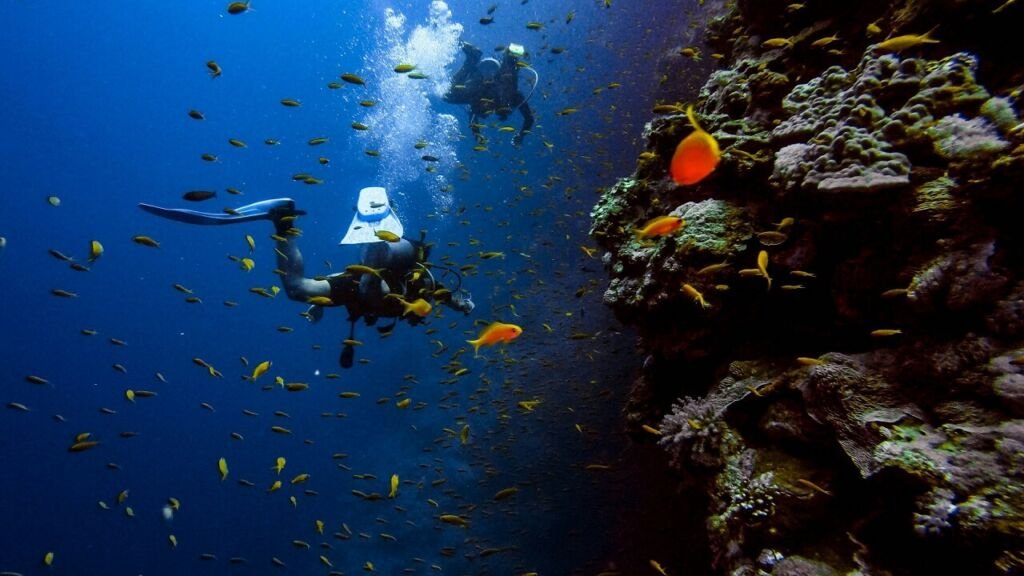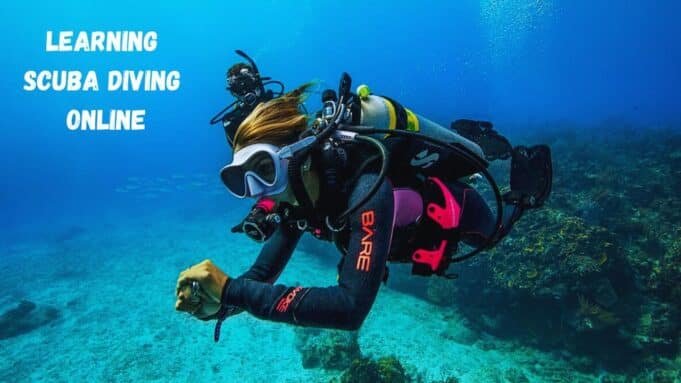Scuba diving opens the door to a world of breathtaking marine life and underwater adventure. For many, however, the idea of learning how to dive can feel overwhelming, especially when juggling travel plans and busy schedules.
That’s where PADI eLearning comes in. As part of the Professional Association of Diving Instructors’ (PADI) global training system, this online platform makes it easier than ever to start your scuba journey from home, saving you time and making diving more accessible.
What is PADI eLearning?
PADI eLearning is a digital learning program that allows aspiring divers to complete the classroom portion of scuba certification online. Instead of sitting through lectures in a dive shop, students study interactive modules that include videos, animations, quizzes, and reading materials.
The program covers a wide range of courses—from beginner levels like Open Water Diver to advanced options such as Rescue Diver and specialties like Enriched Air (Nitrox). By combining online theory with in-person training, PADI ensures divers receive both flexibility and hands-on experience.
How PADI eLearning Works?
The process is simple and designed for convenience. Once you enroll in a course, you gain access to online materials that you can complete at your own pace. Lessons include video demonstrations, knowledge reviews, and short quizzes to reinforce key concepts.
You can use a desktop, tablet, or mobile phone, which makes it easy to study anytime, anywhere. After finishing the online portion, students complete the practical skills training with a certified PADI instructor—either at home or at a dive destination of their choice.
Here are some clear, step-by-step bullet points explaining how PADI eLearning Works:
- Sign Up Online – Enroll in your chosen PADI course through the official website or a local dive center.
- Access Digital Materials – Log in on your computer, tablet, or mobile to begin interactive lessons with videos, animations, and reading modules.
- Learn at Your Own Pace – Complete the knowledge sections, quizzes, and reviews whenever it fits your schedule.
- Track Your Progress – The system saves your place automatically, allowing you to pause and resume anytime.
- Pass Final Assessments – Finish chapter reviews and knowledge tests to ensure you understand key dive theory concepts.
- Connect with a Dive Shop – Schedule your in-person training with a certified PADI instructor.
- Complete Pool Sessions – Practice scuba skills in confined water, such as mask clearing and buoyancy control.
- Finish Open Water Dives – Demonstrate your abilities in the ocean, lake, or quarry to earn your official PADI certification.
Related: Why Try Scuba Diving on a Komodo Liveaboard
Benefits of PADI eLearning
One of the biggest advantages of PADI eLearning is flexibility. You can study at your own pace, revisiting lessons as often as needed. Another benefit is saving valuable vacation time—instead of spending days in a classroom at your destination, you arrive ready to get straight into the water.
Because PADI eLearning provides standardized materials, students worldwide receive the same high-quality training. Finally, the digital format is more environmentally friendly, reducing the need for printed manuals and paper exams.
Learn at Your Own Pace
One of the biggest advantages of PADI eLearning is flexibility. You can study whenever it suits your schedule, whether it’s a few minutes during your lunch break or a full session in the evening. This self-paced format allows learners to review lessons as many times as needed, ensuring a strong understanding of dive theory before getting into the water.
Save Vacation Time
With PADI eLearning, you complete the classroom portion at home, so when you arrive at your dive destination, you can spend more time enjoying the water. Instead of sitting in a classroom during your holiday, you’ll dive straight into pool practice and open water adventures, maximizing your travel experience.
Consistency and Quality Worldwide
PADI’s digital materials are standardized across the globe, meaning every student—no matter where they’re learning—receives the same high-quality education. This ensures that when you show up at a dive shop in Iceland, Thailand, or Mexico, your knowledge matches global training standards.
Environmentally Friendly Learning
By replacing heavy textbooks and paper exams with interactive online modules, PADI eLearning reduces paper waste and helps protect the environment. For divers passionate about the ocean, learning sustainably adds extra value to the certification process.
Courses Available Through PADI eLearning
PADI offers a wide range of online courses to suit different experience levels and goals:
- Open Water Diver – The most popular entry-level certification for beginners.
- Advanced Open Water Diver – Expands your skills with deep diving, navigation, and specialty dives.
- Rescue Diver – Focuses on emergency management and diver safety.
- Specialty Courses – Includes Enriched Air (Nitrox), Digital Underwater Photography, Peak Performance Buoyancy, and more.
- Dive Theory Online – Perfect for aspiring dive professionals preparing for Instructor Development Courses.
READ: Everything You Need To Know About Scuba Diving
Costs and Packages
The cost of PADI eLearning depends on the course, generally ranging from $120 to 200 for the online portion. This fee gives you lifetime access to the digital learning materials. However, it does not include the practical training, which is paid separately to the dive shop where you complete your confined water and open water sessions.
This structure allows flexibility—students can choose a dive center close to home or one located at a dream holiday destination.
Completing the Practical Portion

After finishing the online theory, you must complete in-person training with a certified PADI instructor. This includes confined water sessions (usually in a pool) to practice essential skills such as mask clearing, buoyancy control, and regulator recovery.
Finally, you’ll complete open water dives in a lake, quarry, or the ocean, demonstrating your skills under real-world conditions. Once completed, you earn your official PADI certification card, recognized worldwide.
Who Should Take PADI eLearning?
PADI eLearning is ideal for anyone who values flexibility and efficiency. Busy professionals can learn at their own pace, families can prepare together before a vacation, and travelers can reduce classroom time at their destination.
It’s also great for students who prefer digital resources over traditional textbooks. Whether you’re a beginner or advancing your skills, PADI eLearning adapts to your schedule.
Tips for Success with PADI eLearning
To get the most out of your eLearning experience:
- Schedule study sessions regularly instead of cramming all at once.
- Take notes on important dive theory topics, especially safety and equipment use.
- Practice with videos—watch demonstrations more than once for clarity.
- Contact a dive shop early to arrange your in-water training and confirm availability.
- Stay motivated by setting a goal, like completing your certification before an upcoming holiday.
Read More: Iceland Tectonic Plates Diving Tours
How Long Does It Take To Complete PADI eLearning?
Most students finish PADI eLearning in 8 to 12 hours, but the exact time depends on your pace, focus, and the course you’re taking. For example, the Open Water Diver course may take a beginner longer, while advanced courses like Nitrox or Rescue Diver might be completed more quickly by experienced divers.
Because it’s self-directed, you can spread the lessons over several days or complete them in one weekend. Each chapter includes knowledge reviews, quizzes, and videos that reinforce learning, making it easy to retain information. The flexibility means busy professionals, students, or families can fit learning around their lifestyle.
What Courses Are Available Through PADI eLearning?
PADI eLearning offers a variety of courses for every stage of diving. Beginners usually start with the Open Water Diver course, which covers safety basics, dive planning, and equipment use. For those with certification, the Advanced Open Water Diver course introduces deep diving, underwater navigation, and elective adventure dives. The Rescue Diver course is designed to improve emergency response and build confidence underwater.
Specialty courses include Enriched Air (Nitrox) for longer bottom times, Digital Underwater Photography for capturing marine life, Peak Performance Buoyancy to master underwater control, and more. Professional-level courses like Dive Theory Online prepare aspiring instructors. This range ensures learners can progress from first-timers to pros entirely within the PADI eLearning system.
Do I Still Need In-Person Training After eLearning?
Yes, completing the in-water training is essential to becoming a certified diver. PADI eLearning only covers dive theory—things like decompression theory, dive planning, and equipment use. Once you’ve finished online modules, you’ll complete confined water sessions (usually in a swimming pool) with a PADI instructor to practice skills such as regulator recovery, buoyancy control, and emergency procedures.
After this, you’ll move on to open water dives in the ocean, a lake, or another natural body of water. This hands-on component ensures you can apply what you learned online in real-world conditions, building confidence and safety awareness. Only after completing both the online and in-water portions will you earn your official PADI certification card, recognized worldwide.
How Much Does PADI eLearning Cost?
The cost of PADI eLearning varies depending on the course, but most range from $120 to 200 for the online portion. This fee covers digital learning materials, videos, quizzes, and access to the PADI platform. However, the practical training portion (confined water and open water dives) is a separate cost paid directly to the dive center you choose. The in-person training can vary widely depending on location, typically anywhere from $200 to $400.
Some dive shops offer bundled packages that include both eLearning and training for a single price. It’s a good idea to research local dive centers or destination-based schools in advance to compare costs and ensure availability.
Can I Use Any Device for PADI eLearning?
Yes—PADI eLearning is designed for flexibility and works on desktops, laptops, tablets, and smartphones. The platform syncs progress across devices, allowing you to start lessons on a computer at home and continue them on your mobile device while traveling. The interface is user-friendly, with video demonstrations, animations, and interactive quizzes that work seamlessly on all platforms.
You can even download sections of the course to study offline, which is especially useful if you’re traveling somewhere with limited internet access. This multi-device capability ensures that divers can learn anytime, anywhere, without being tied to a classroom.
Read Also: Snorkeling in Silfra Fissure
Is PADI eLearning Suitable For Beginners?
Yes—PADI designed the Open Water Diver eLearning course specifically for beginners, even those with no prior diving or snorkeling experience. The modules utilize simple explanations, step-by-step videos, and knowledge reviews to ensure a clear understanding of key concepts, including underwater communication, equalization, and safe ascent rates.
Each lesson builds gradually, so learners don’t feel overwhelmed. Many families choose PADI eLearning together, allowing parents and children (over the minimum age of 10) to prepare as a group. Because it is self-paced, beginners can revisit lessons as often as needed until they feel confident before moving to the in-water training.
How Long Is My eLearning Access Valid?
When you purchase a PADI eLearning course, you typically have 12 months to complete the online portion. This gives plenty of flexibility for learners with busy schedules. Once you’ve finished, your digital course materials remain available as a lifetime reference, meaning you can revisit chapters, videos, and dive tables long after certification.
This ongoing access is useful for refreshing your memory before a dive trip or reviewing safety concepts. If you don’t complete the online portion within 12 months, you may need to re-enroll, so it’s best to plan and set a study schedule that works for you.
Conclusion
PADI eLearning makes scuba diving more accessible than ever, combining the convenience of online learning with the excitement of real-world underwater training. By completing your theory work at home, you’ll save valuable time on vacation and arrive ready to dive into adventure. Whether you’re dreaming of exploring coral reefs, swimming alongside marine life, or pursuing a professional diving career, PADI eLearning is the perfect first step toward discovering the underwater world.












